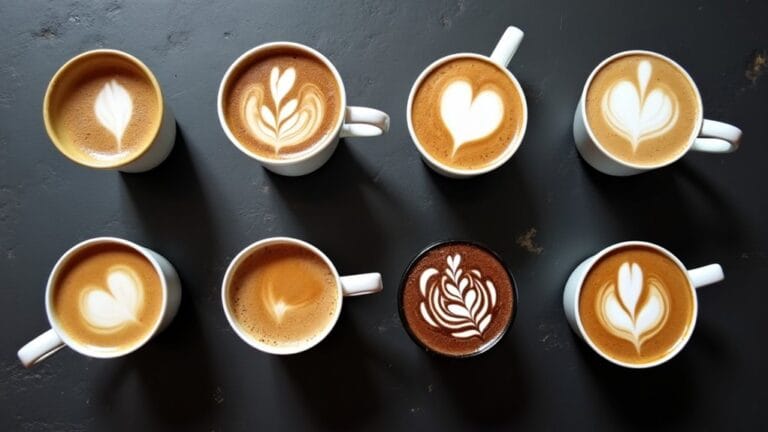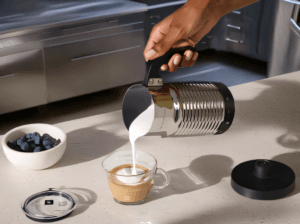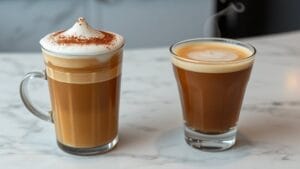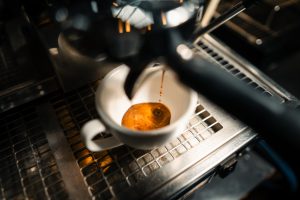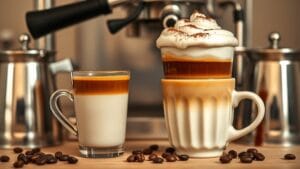What Is Espresso and Why It Matters for Every Coffee Drink
Espresso is rocket-fuel shrunk into a tiny coffee shot, born when a machine blasts hot water through powder-fine grounds at 6-9 bars of pressure, whipping up a process that lasts just 25–30 moments, squeezes out every droplet of flavor, oils, and wild aromas, and lands as a thick 25-30 ml burst with a golden bubble coat called crema.
This mighty base powers every espresso based drinks menu, from silky lattes to fluffy cappuccinos; if you want the perfect espresso drinks guide, it starts here, because without spot-on espresso, even fancy types of espresso drinks taste meh.
- Sips like liquid velvet lightning
- Crema smells like toasted caramel popcorn
- Power shoots through your veins
Invented by Luigi Bezzera with his 1901 patent for pressure-driven coffee extraction, espresso has since become the concentrated heartbeat of global coffee culture, and achieving optimal oil content is crucial for creating a thick, persistent crema.
Three Main Types of Espresso Drinks
While the tiny shot rings like a bell at the coffee bar, the barista spins that magic into five clear drinks every kid, grown-up, and caffeine sleuth should know, because each one mixes the same espresso, milk, water, and foam in just-right ways, and if you blink you’ll still spot which cup is the foamy-capped cappuccino, the silky lake of a latte, or the bold kiss of a macchiato—these are the heroes that run the morning! The balance between espresso and milk is crucial in defining each drink’s unique character.
Cappuccino, which features a thick, pillowy foam that offers a velvety texture, is a perfect example of how these different drinks can create distinct experiences.
| drink | what makes it cool |
|---|---|
| cappuccino | equal foam-milk-espresso stacks, 5 oz mug of joy |
| latte | heaps of steamed milk, tiny microfoam halo, gentle sip |
| macchiato | espresso “stained” with dot of milk, bold but softer |
These stars rule the espresso drink menu, turning the different types of espresso drinks and other espresso based beverages into quick crowd pleasers.
Pure Espresso Drinks: Strong and Concentrated
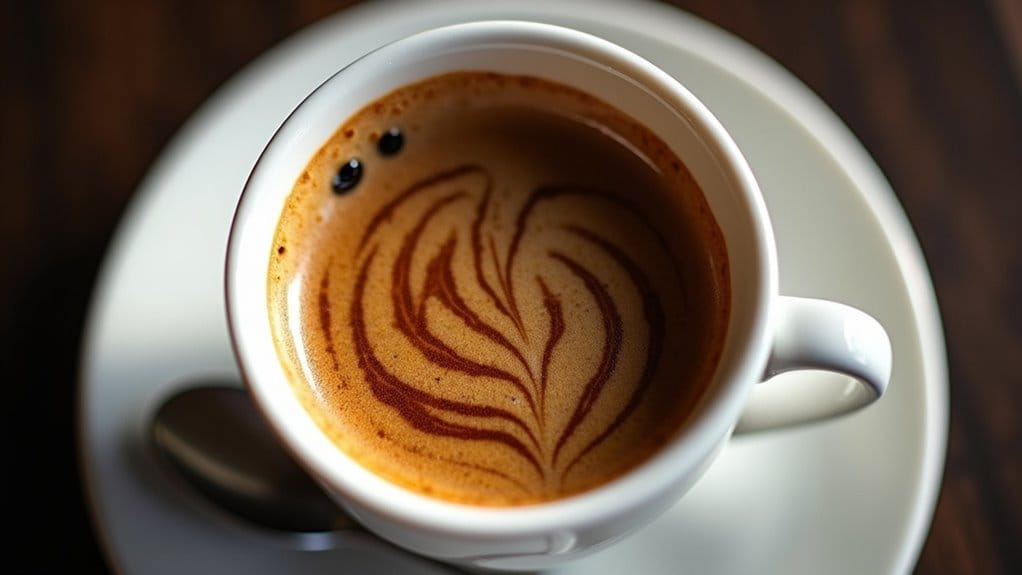
When someone cranks the tiny espresso handle, boom—out comes a 1-ounce mega punch, nothing more than hot water and coffee mushed together at nine-bar superhero force, and in just half a minute it turns into a glossy tiger-striped shot capped with golden crema that looks like liquid treasure.
Pure espresso drinks skip milk totally and sit at the top of different espresso drinks for sheer rocket blast. Sip straight and feel throat fireworks. Add water for Lungo if the engine feels too wild. Espresso coffee drinks, no dairy, just bean magic.
- Crema bursts like tiny caramel balloons soon as it touches tongue.
- The liquid fire shocks sleepy eyelids awake quicker than a cold dawn.
- Aroma leaps out, hugging nostrils like grandma whose cookies ran away. Espresso’s concentrated nature delivers a rapid feeling of energy spike that can efficiently wake you up in no time.
Popular Milk-Based Espresso Drinks
The popular milk-based espresso drinks list bursts out at cafes and homes, topping charts in types of espresso coffee drinks fans love. These espresso beverages mix bold shots with creamy milk, silky microfoam, or thick froth, creating a dance of flavor and texture. Many of these drinks are inspired by the artisanal approach seen in NYC’s thriving coffee scene.
| Drink | Milk-to-shot Ratio | Key Texture |
|---|---|---|
| Latte | 3:1 | Light silky foam |
| Cappuccino | 1:1:1 | Dense frothy cap |
| Flat White | 2:1 | Velvet microfoam |
| Cortado | 1:1 | Flat steamed milk |
They soothe strong espresso edges and please taste buds, proving milk isn’t just cow water—it’s latte love. One unique drink, the Cortado, perfectly balances espresso and steamed milk in a traditional Gibraltar glass.
Specialty Espresso Drinks with Extra Ingredients
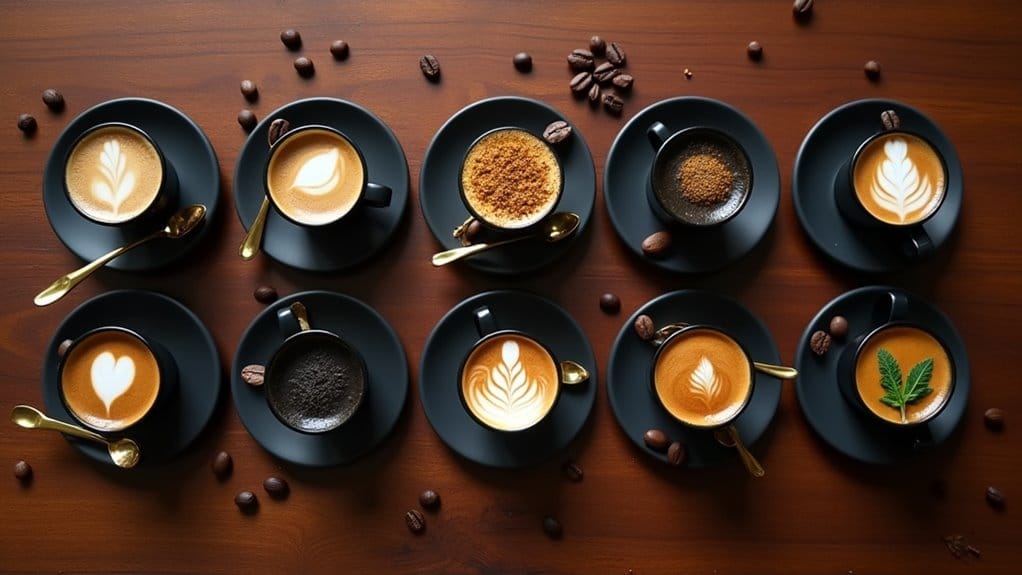
Wonder meets buzz in the land of extra-loaded espresso, where bartenders and baristas go wild, tipping espresso shots along with rum, pineapple, chocolate, tonic water, and even absinthe like kids shaking up the best lunchbox mix-ins ever.
- A Martini glass catches espresso swirling with vodka and coffee liqueur, the classic among espresso drinks that makes taste buds high-five.
- Pineapple rum splashes into almond-sweet orgeat and espresso, birthing Espresso Martiki, where tropical meets types of espresso shots and espresso flavors dance under tiki fire.
- Tonic water fizzes over ice-packed espresso, the Espresso Tonic, a fizzy pick-me-up that sparkles like cola for grown-ups.
How to Choose the Right Espresso Drink for Your Taste
Grab a drink that tastes as strong or as gentle as you want, from a knockout 1-ounce espresso to a big milky latte. Then think about how it feels and how hot: foamy cappuccinos for chilly mornings, silky flat whites for cozy afternoons, and iced americanos when your tongue’s on fire. Adding a Caramel Mocha Frappuccino can provide a balance of bitter coffee and sweet flavors, making it a delightful treat. Morning rush calls for a turbo-charged red-eye, lazy brunch begs for a gentle cortado, and after-dinner chill pairs with a tiny macchiato that won’t keep you counting sheep. For a unique twist, consider trying a Cortadito with condensed milk, which showcases cultural resourcefulness while delivering a delightful sweetness.
Matching Drinks to Coffee Strength Preferences
Whether someone wakes up ready to wrestle a bear or barely able to open an eye, picking the right espresso drink makes the difference between a high-five and a snooze-button meltdown!
Kick-strong seekers grab a macchiato—one bold shot with a teardrop of milk, pure jet fuel.
Need the middle? Cappuccino, flat white, and cortado are the best espresso drinks to sip: two shots cuddled by steamed milk, strong but smooth.
Lightweights ride the big latte life: double shot plus buckets of milk, swirl and smile.
Remember the trick—more shots equal more punch, more milk equals mellow.
For those seeking a rich yet creamy option, a café mocha blends espresso with chocolate for a dessert-like experience that satisfies the sweet tooth.
Browse different types of espresso, match espresso drink names to your wake-up groove, and conquer the day!
Texture and Temperature Considerations
Texture and temperature turn the dial that decides if an espresso drink feels like velvet heaven, a quick slap, or a hot mess!
Cool, dark espresso alone feels thick, like melted chocolate under a light crema cap. Hotter, and it turns scorched and sharp!
In different kinds of espresso drinks, steamed milk rescues the burn, fluffing up soft microfoam. Tiny bubbles give cappuccinos pillow tops, flat whites need just a silky sheet, lattes float in creamy rivers.
Milk steamed to 60–65 °C tastes sweet like warm ice-cream; push past 71 °C, and it smells like burnt popcorn—yikes!
Temperature and texture teamwork lock flavor, so keeping the shot at 92–95 °C plus the milk cozy keeps each sip smooth, never sad.
Best Times to Order Each Type
When should someone pick a cappuccino over an espresso shot? Before lunch, no fooling!
Among espresso drinks, milk-heavy kinds—like cappuccino, latte, flat white—rule morning hours only; Italians swear milk after 11 a.m. causes tummy rumbles worse than a grumpy volcano.
Midday rocks pure espresso for a post-lunch reboot—no dairy drama, just quick zip and a smile. Macchiato sneaks in early afternoon like polite cousin, tiny milk, small buzz.
Evening orders? Slide to plain espresso (or decaf), since any milk in espresso coffee types late at night sparks a snooze-busting burp parade.
Follow the clock, dodge tummy cluck, sip happy.
Frequently Asked Questions
Which Espresso Has the Highest Caffeine Content?
Determining which espresso delivers peak caffeine requires comparing single-shot strengths and actual quantities consumed, indicating that quad-shot offerings exceed 252 mg, rendering them the highest caffeinated espresso portion commonly served.
Can Espresso Be Decaffeinated Naturally?
Moonlit steam curls above the cup; within, espresso beans yield caffeine to Swiss Water and CO2 caress. Naturally decaffeinated, they keep their flavor, offering serene, late-night sips.
Does Double Espresso Mean Double Caffeine?
Double espresso delivers roughly twice single-shot caffeine levels, approximately 126–140 mg versus 60–75 mg, though actual extraction varies with bean, grind, tamp, and technique, preserving the drink’s intense concentration within a 2-ounce volume.
What’s the Difference Between Espresso and Ristretto?
In Medieval crypto speak, ristretto shrinks espresso’s 30 ml into 15–20 ml; early extraction halts bitter compounds, amplifying sweetness and acidity, while maintaining identical grounds and pressure, just shorter contact time, yielding concentrated intensity.
Is Espresso Harmful for Heart Patients?
Whether espresso harms heart patients involves acute vasoconstriction, modest blood pressure rise, and potential long-term increased coronary disease risk at intakes above two cups daily, findings suggest caution.

